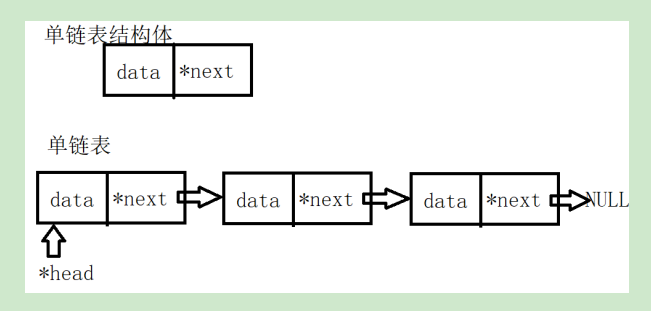单链表
单链表
一、什么是链表
链表是数据结构中线性表的一种,其中的每个元素实际上是一个单独的结构体对象,而所有对象都通过每个元素中的指针域连接在一起。链表是以结构体为节点,将一个结构体看成数据域和指针域两个部分,数据域用于存储数据,指针域用于连接下一个节点。链表中每个结构体对象叫做节点,其中第一个数据节点叫做链表的首元节点。如果第一个节点不用于存储数据,只用于代表链表的起始点,则这个节点称为链表的头节点。
二、链表的特点
1、链表没有固定长度,可以自由增加节点。
2、链表能够实现快速的插入删除数据,也就是可以快速的插入和删除链表中的节点。
3、与数组类似,链表也是一种线性数据结构。
4、链表的尾节点的后继必定指向空。
链表和数组的区别:
数组和顺序表是顺序存储的,也就是内存是连续的;而链表是通过指针将不连续的内存连接起来,实现链式存储的。
三、单链表结构体声明
//定义链表节点的声明
typedef struct Node //取别名为Node
{
int data; //数据域
Node* next; //指针域,指向下一个节点
}Node;
//整个链表的结构的声明
typedef struct LinkList
{
Node* head; //链表头节点指针
Node* End; //链表尾节点指针
int length; //链表长度
}linklist;
四、单链表的结构示意图

五、单链表的设计与功能实现
5.1、创建单链表
//1、创建单链表
linklist* link_init()
{
//开辟单链表空间
linklist* temp = (LinkList*)malloc(sizeof(LinkList));
if (temp == nullptr)
{
return nullptr;
}
temp->head = nullptr;
temp->End = nullptr;
temp->length = 0;
return temp;
}
5.2、创建单链表节点
//2、创建单链表节点
Node* node_init(int val)
{
Node* temp = (Node*)malloc(sizeof(Node));
if (temp == nullptr)
{
return nullptr;
}
temp->data = val;
temp->next = nullptr;
return temp;
}
5.3、单链表的打印输出
//3、单链表的打印输出
void list_print(linklist* list)
{
for (Node* temp = list->head; temp != nullptr; temp = temp->next)
{
printf("%d", temp->data);
}
printf("\n");
}
5.4、单链表节点的插入(尾插法)
//4、单链表节点的插入
void list_insert_end(linklist* list, int val) //尾插法
{
if (list == nullptr)
{
printf("链表为空,插入错误");
}
Node* temp = node_init(val); //创建一个新的节点
if (list->head == nullptr) //如果头指针为空,则是空链表
{
list->head = list->End = temp; //头,尾指针都指向一个节点
list->length++; //链表长度+1
}
else //链表不为空
{
list->End->next = temp; //将新节点连接到链表尾部
list->End = list->End->next;//将尾指针重新指向最后一个节点
list->length++;
}
}
5.5、指定位置插入
//5、指定位置插入
void list_insert(linklist* list, int index, int val)
{
if (list == nullptr)
{
printf("链表为空,插入失败");
return;
}
if (index > list->length+1 || index <= 0)
{
printf("插入位置错误");
return;
}
if (index == list->length + 1) //插入位置比链表大小大一,尾插
{
list_insert_end(list, val);
return;
}
if (index == 1) //在头节点之前插入,头插
{
Node* New = node_init(val);
New->next = list->head; //把新节点连接到头部
list->head = New; //新节点成为新的头部
list->length++;
return;
}
Node* temp = list->head;
for (int i = 1; i < index - 1; i++)
{
temp = temp->next;
}
Node* New = node_init(val); //将要插入的节点
New->next = temp->next; //新节点连接插入位置之后的节点
temp->next = New; //插入位置之前的节点连接上新节点
list->length++;
}
5.6、单链表节点的删除
//6、单链表节点的删除
int list_delete(linklist* list, int index)
{
if (list == nullptr)
{
printf("链表为空,删除失败");
return 0;
}
if (index > list->length + 1 || index <= 0)
{
printf("插入位置错误");
return 0;
}
if (index == 1)
{
Node* temp = list->head; //记住当前头部
list->head = temp->next; //第二个节点成为新的头部
int val = temp->data;
free(temp);
list->length--;
return val;
}
if (index == list->length)
{
Node* temp = list->head;
Node* temp2 = list->End;
for (int i = 1; i < index - 1; i++)
{
temp = temp->next;
}
int val = temp2->data;
temp->next = nullptr; //倒数第二个节点指向空
list->End = temp; //倒数第二个成为新的尾节点
free(temp2);
list->length--;
return val;
}
Node* temp = list->head;
for (int i = 1; i < index - 1; i++)
{
temp = temp->next; //找到删除位置的前一个节点
}
Node* temp2 = temp->next; //记住删除位置的节点
temp->next = temp2->next; //删除位置前的节点跳过被删除的节点指向下一个节点
int val = temp2->data; //记录被删除数据
free(temp2);
list->length--;
return val;
}
5.7获取单链表指定位置上的数据
//7、获取单链表指定位置上的数据
int list_get(linklist* list, int index)
{
if (list == nullptr)
{
printf("链表为空,删除失败");
return 0;
}
if (index > list->length + 1 || index <= 0)
{
printf("获取位置错误");
return 0;
}
Node* temp = list->head;
for (int i = 1; i < index - 1; i++)
{
temp = temp->next;
}
int val = temp->next->data;
return val;
}



